Most health care providers who were using telehealth by August 2021 felt optimistic about virtual care in a study from GoodRx on The State of Telehealth.
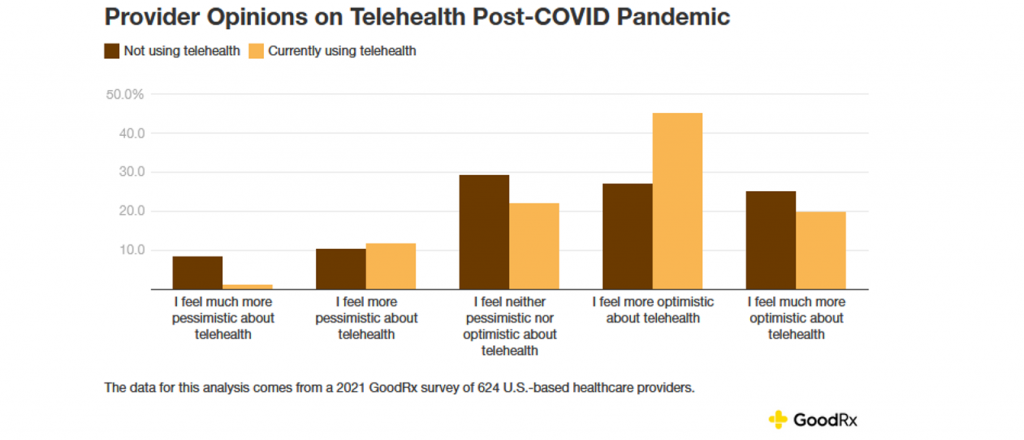
GoodRx collaborated with the ATA on the 624 U.S. provider survey, which was complemented by a poll conducted among 1,024 health consumers for the patient perspective in September 2021.
Looking at the two columns at the right side of the first bar chart, clinicians who have been using telehealth were more likely to feel optimistic about doing so than providers who were not.
The most prevalent platforms providers used for telehealth engagement were via Zoom, the EHR provider (with Epic MyChart and Cerner broken out separately), or FaceTime.
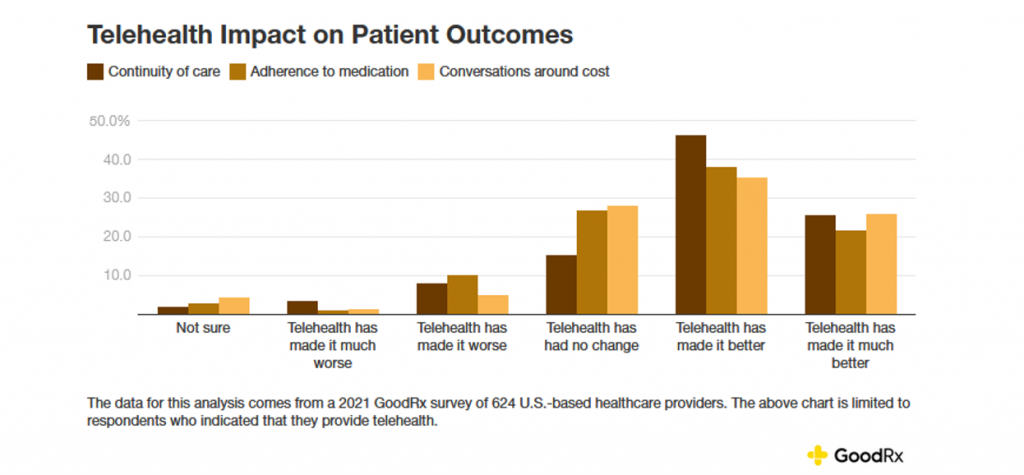 Among providers using telehealth, again looking at the two right side bar groups in the second chart, virtual care has improved continuity of care, bolstered patient adherence to medication, and benefited conversations around costs with patients.
Among providers using telehealth, again looking at the two right side bar groups in the second chart, virtual care has improved continuity of care, bolstered patient adherence to medication, and benefited conversations around costs with patients.
The pandemic has also grown the types of services providers were offering via telehealth beyond traditional triage or real-time consults for urgent medical issues when doctor’s offices were closed.
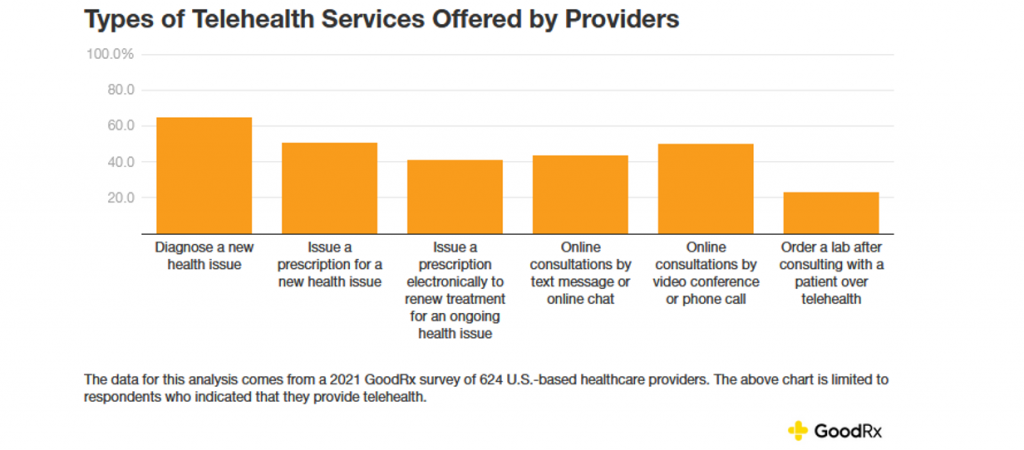
The third chart from the study breaks out different services that providers offered via telehealth, topped by diagnosing new health issues, initiating prescriptions for a new health issue, consulting online via video conference or phone call, text message or online chat, or ordering a lab test after consulting with a patient.
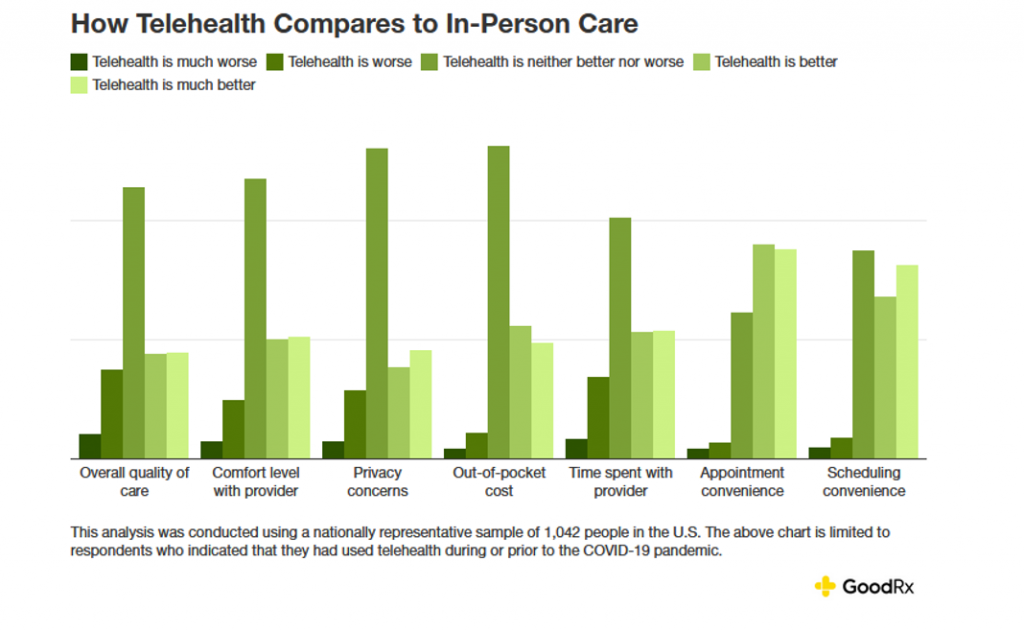 GoodRx then assessed the patient view on telehealth engagement, asking consumers how telehealth compared with in-person care. Based on the fourth table in shades of green, we can see for all categories but one (appointment convenience), the middle green shade dominated peoples’ opinions that telehealth was neither better nor worse — thus, roughly the same experience — for overall quality of care, comfort level with the provider, privacy, out-of-pocket cost, time spent with the provider, and schedule convenience.
GoodRx then assessed the patient view on telehealth engagement, asking consumers how telehealth compared with in-person care. Based on the fourth table in shades of green, we can see for all categories but one (appointment convenience), the middle green shade dominated peoples’ opinions that telehealth was neither better nor worse — thus, roughly the same experience — for overall quality of care, comfort level with the provider, privacy, out-of-pocket cost, time spent with the provider, and schedule convenience.
The area where most patients used telehealth for the first time using the pandemic was for mental and behavioral health, followed by chronic care treatment.
Health Populi’s Hot Points: GoodRx found that many consumers interacted with providers more due to telehealth access and experience.
This reinforces the concept of a hybrid model of care — which I’ve been advising and writing about as omni-channel care in terms of delivering care where patients “are” and want to be: at home, at work, in the community, the barbershop, the retail store or pharmacy….and indeed, back in the doctor’s office or clinic if that’s indeed where a patient wants to meet with their clinician.
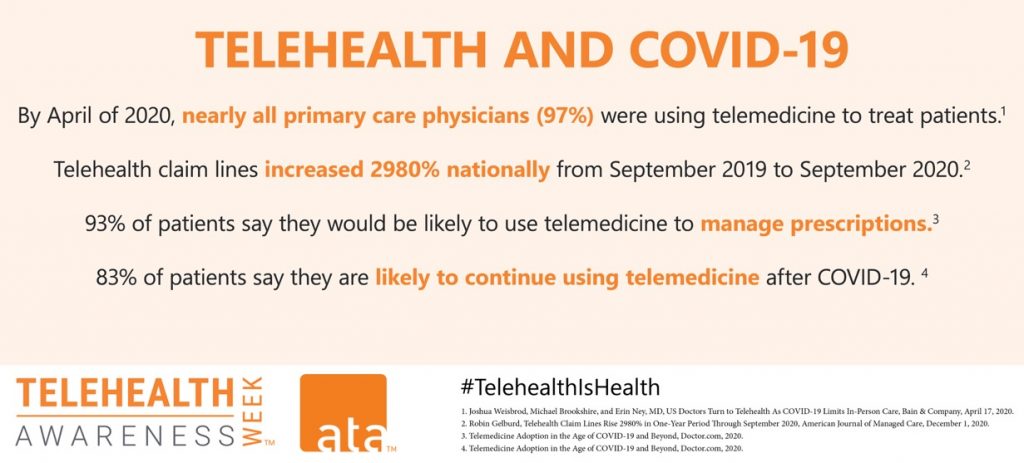 Another facet to consider in this study is that it was sponsored by GoodRx, whose core business was in the online prescription drug space. In the past year, the company has been pivoting toward telehealth and health care services beyond-the-pill/prescription.
Another facet to consider in this study is that it was sponsored by GoodRx, whose core business was in the online prescription drug space. In the past year, the company has been pivoting toward telehealth and health care services beyond-the-pill/prescription.
We are seeing other transformations from, for example, Teladoc recently announced the company’s work on a virtual-first health care plan with TrustMark. Similarly in the omni-channel collaboration world, Hims & Hers is collaborating with Walgreens expanding their channel through retail pharmacy.
As Ann Mond Johnson, CEO of the ATA, says: #TelehealthIsHealth.
And it seems from the GoodRx assessment of the State of Telehealth, patients and providers increasingly agree with Ann’s take on the new normal for health care delivery.


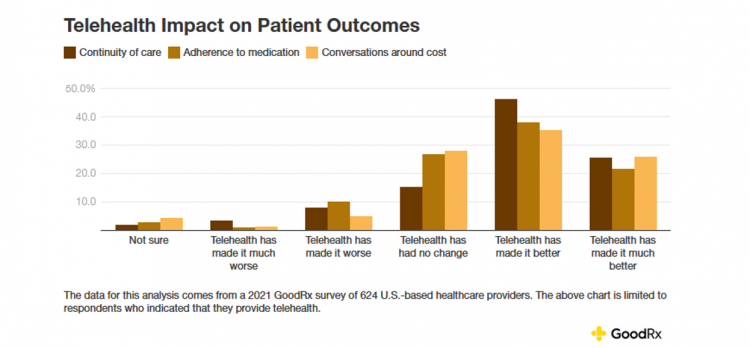


 Interviewed live on BNN Bloomberg (Canada) on the market for GLP-1 drugs for weight loss and their impact on both the health care system and consumer goods and services -- notably, food, nutrition, retail health, gyms, and other sectors.
Interviewed live on BNN Bloomberg (Canada) on the market for GLP-1 drugs for weight loss and their impact on both the health care system and consumer goods and services -- notably, food, nutrition, retail health, gyms, and other sectors. Thank you, Feedspot, for
Thank you, Feedspot, for  As you may know, I have been splitting work- and living-time between the U.S. and the E.U., most recently living in and working from Brussels. In the month of September 2024, I'll be splitting time between London and other parts of the U.K., and Italy where I'll be working with clients on consumer health, self-care and home care focused on food-as-medicine, digital health, business and scenario planning for the future...
As you may know, I have been splitting work- and living-time between the U.S. and the E.U., most recently living in and working from Brussels. In the month of September 2024, I'll be splitting time between London and other parts of the U.K., and Italy where I'll be working with clients on consumer health, self-care and home care focused on food-as-medicine, digital health, business and scenario planning for the future...